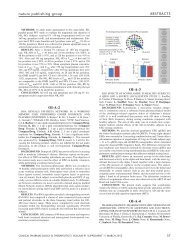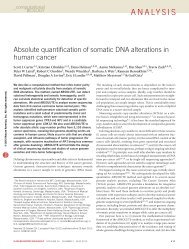open access: Nature Reviews: Key Advances in Medicine
open access: Nature Reviews: Key Advances in Medicine
open access: Nature Reviews: Key Advances in Medicine
You also want an ePaper? Increase the reach of your titles
YUMPU automatically turns print PDFs into web optimized ePapers that Google loves.
UROLOGY<br />
<strong>Key</strong> advances<br />
■ Abiraterone acetate can now be<br />
considered standard of care for patients<br />
with CRPC who progress on docetaxel 1<br />
■ Dual blockade of the PI3K–AKT pathway<br />
and the androgen receptor has emerged<br />
as an important potential strategy for<br />
revers<strong>in</strong>g castration resistance 5<br />
■ Precl<strong>in</strong>ical validation of target<strong>in</strong>g of<br />
PARP <strong>in</strong> ETS-positive cancers <strong>in</strong>troduces<br />
a potential new biologically rational<br />
approach for treat<strong>in</strong>g advanced prostate<br />
cancer 7<br />
■ Denosumab is superior to zoledronic acid<br />
<strong>in</strong> delay<strong>in</strong>g skeletal-related events <strong>in</strong> men<br />
with bone metastasis 9<br />
■ Radium 223 chloride improves survival<br />
<strong>in</strong> patients with advanced CRPC and<br />
symptomatic bone metastases 10<br />
ow<strong>in</strong>g to ETS gene rearrangements has<br />
been directly implicated <strong>in</strong> tumor <strong>in</strong>vasion<br />
and metastasis <strong>in</strong> prostate cancer cell<br />
l<strong>in</strong>es; therefore, the downregulation of these<br />
prote<strong>in</strong>s could help expla<strong>in</strong> the antitumor<br />
activity of therapeutics that disrupt AR signal<strong>in</strong>g<br />
<strong>in</strong> nonselected patients. Accord<strong>in</strong>gly,<br />
it has been suggested that direct target<strong>in</strong>g<br />
of ETS prote<strong>in</strong>s could avoid the toxicity<br />
and AR-related drug resistance of<br />
hormone therapies.<br />
In a study published this year, Brenner<br />
et al. 7 screened for prote<strong>in</strong>s that <strong>in</strong>teract<br />
with ERG. They found that trans cription<br />
regulated by both ERG and ETV1 was<br />
mediated by a prote<strong>in</strong> complex compris<strong>in</strong>g<br />
PARP1 (poly ADP-ribose polymerase 1)<br />
and DNAPKcs (DNA-dependent prote<strong>in</strong><br />
k<strong>in</strong>ase, catalytic subunit), and that disruption<br />
of this complex us<strong>in</strong>g PARP1 <strong>in</strong>hibitors<br />
suppressed growth of ETS-driven cancers.<br />
Moreover, it has also been hypothesized<br />
that some sporadic prostate cancers (possibly<br />
those <strong>in</strong>volv<strong>in</strong>g loss of PTEN) conta<strong>in</strong><br />
DNA repair defects, so PARP1 <strong>in</strong>hibition<br />
could function as an effective therapy either<br />
directly via synthetic lethality or <strong>in</strong>directly<br />
through <strong>in</strong>hibition of the PARP1–ETS<br />
complex. 8 Studies of PARP <strong>in</strong>hibitors, both<br />
alone and <strong>in</strong> comb<strong>in</strong>ation with AR-target<strong>in</strong>g<br />
drugs, are now planned.<br />
Target<strong>in</strong>g of bone metastases has long<br />
been a priority <strong>in</strong> CRPC, because of both<br />
its frequent occurrence and associated<br />
morbidity. The phase III double-bl<strong>in</strong>d<br />
study of denosumab, a humanized monoclonal<br />
antibody aga<strong>in</strong>st receptor activator<br />
of nuclear factor κB ligand (RANKL;<br />
a stimulator of osteoclastic bone resorption)<br />
versus zoledronic acid was published<br />
earlier this year. 9 Although denosumab<br />
treatment resulted <strong>in</strong> a 3.6-month advantage<br />
<strong>in</strong> the composite end po<strong>in</strong>t of time to<br />
a skeletal-related event (SRE), there was no<br />
alteration <strong>in</strong> overall survival or disease progression.<br />
The cl<strong>in</strong>ically important adverse<br />
event of jaw osteonecrosis was rare, occurr<strong>in</strong>g<br />
<strong>in</strong> 22 patients <strong>in</strong> the denosumab group<br />
and 12 men who received zoledronate.<br />
These results suggest that denosumab is<br />
more effective at delay<strong>in</strong>g SREs than the<br />
current standard. Denosumab also offers<br />
advantages <strong>in</strong> terms of its subcutaneous<br />
adm<strong>in</strong>istration and a lesser requirement<br />
for renal monitor<strong>in</strong>g; however, cost may<br />
limit its widespread use.<br />
The potential survival benefit of effective<br />
bone target<strong>in</strong>g was proven <strong>in</strong> the recently<br />
presented phase III ALSYMPCA trial,<br />
test<strong>in</strong>g the <strong>in</strong>travenously delivered alphaemitter<br />
radium 223 chloride, which <strong>in</strong>corporates<br />
<strong>in</strong> place of calcium <strong>in</strong> replicat<strong>in</strong>g<br />
bone caus<strong>in</strong>g double-strand DNA damage<br />
<strong>in</strong> adjacent cells. ALSYMPCA compared<br />
radium 223 chloride with best supportive<br />
care <strong>in</strong> men with symptomatic bone-only<br />
meta stases. 10 The trial was unbl<strong>in</strong>ded after<br />
the preplanned <strong>in</strong>terim analysis met efficacy<br />
criteria, demonstrat<strong>in</strong>g a 2.8-month<br />
improvement <strong>in</strong> the primary survival<br />
end po<strong>in</strong>t <strong>in</strong> the radium 223 chloride group<br />
(HR 0.695; P = 0.00185). Secondary efficacy<br />
end po<strong>in</strong>ts of time to SRE, time to<br />
PSA progression, and extent and duration<br />
of alkal<strong>in</strong>e phosphatase response also<br />
favored the experimental arm. The rate of<br />
hemato logical toxicity was low, but there<br />
was an <strong>in</strong>creased rate of grade 1–2 diarrhea<br />
observed <strong>in</strong> patients who received<br />
active treatment. Radium 223 chloride could<br />
therefore prove to be a highly effective<br />
treatment with low morbid ity for men with<br />
bone metastases.<br />
In summary, significant milestones <strong>in</strong><br />
prostate cancer research <strong>in</strong> 2011 <strong>in</strong>cluded<br />
announcement of the results of two positive<br />
phase III trials (ALSYMPCA and<br />
AFFIRM); grant<strong>in</strong>g of market<strong>in</strong>g approval<br />
for abiraterone acetate by the FDA and the<br />
EMA; and approval of cabazitaxel, already<br />
approved by the FDA <strong>in</strong> 2010, by the EMA.<br />
Furthermore, <strong>in</strong>creased use of the autologous<br />
vacc<strong>in</strong>e therapy sipuleucel-T for<br />
the treatment of predom<strong>in</strong>antly chemotherapy-naive<br />
patients was reported <strong>in</strong> the<br />
USA. Over the next 12 months physicians<br />
could therefore have at their disposal five<br />
new agents (abiraterone acetate, MDV3100,<br />
cabazitaxel, sipuleucel-T and radium 223<br />
chloride) <strong>in</strong> addition to docetaxel that<br />
prolong the life of patients with CRPC, and<br />
a second bone-modulat<strong>in</strong>g agent <strong>in</strong> addition<br />
to bisphosphonates (denosumab).<br />
Additionally, an unprecedented number of<br />
cl<strong>in</strong>ical trials are currently accru<strong>in</strong>g patients<br />
with prostate cancer to test promis<strong>in</strong>g novel<br />
therapies. The therapeutic landscape of<br />
CRPC has certa<strong>in</strong>ly been redef<strong>in</strong>ed over the<br />
past 2 years. It is now anticipated that significant<br />
further advances will require biologically<br />
rational target<strong>in</strong>g of mol ecularly<br />
def<strong>in</strong>ed subgroups.<br />
Section of Medic<strong>in</strong>e, The Institute of Cancer<br />
Research and the Royal Marsden NHS<br />
Foundation Trust, Downs Road, Sutton, Surrey<br />
SM2 5PT, UK (C. Pezaro, G. Attard).<br />
Correspondence to: G. Attard<br />
gerhardt.attard@icr.ac.uk<br />
Compet<strong>in</strong>g <strong>in</strong>terests<br />
G. Attard declares associations with the follow<strong>in</strong>g<br />
companies/organizations: AstraZeneca, The<br />
Institute of Cancer Research, Ipsen, Janssen-Cilag<br />
and Sanofi-Aventis. See the article onl<strong>in</strong>e for full<br />
details of the relationships. C. Pezaro declares no<br />
compet<strong>in</strong>g <strong>in</strong>terests.<br />
1. de Bono, J. S. et al. Abiraterone and <strong>in</strong>creased<br />
survival <strong>in</strong> metastatic prostate cancer. N. Engl.<br />
J. Med. 364, 1995–2005 (2011).<br />
2. Attard, G. & de Bono, J. S. Translat<strong>in</strong>g scientific<br />
advancement <strong>in</strong>to cl<strong>in</strong>ical benefit for castrationresistant<br />
prostate cancer patients. Cl<strong>in</strong>. Cancer<br />
Res. 17, 3867–3675 (2011).<br />
3. Scher, H. I. et al. Evaluation of circulat<strong>in</strong>g tumor<br />
cell enumeration as an efficacy response<br />
biomarker of overall survival <strong>in</strong> metastatic<br />
castration-resistant prostate cancer (mCRPC):<br />
Planned f<strong>in</strong>al analysis of COU-AA-301, a<br />
randomized, double-bl<strong>in</strong>d, placebo-controlled,<br />
phase III study of abiraterone acetate plus lowdose<br />
prednisone post docetaxel [abstract].<br />
J. Cl<strong>in</strong>. Oncol. 29, LBA4517 (2011).<br />
4. Mulholland, D. J. et al. Cell autonomous role of<br />
PTEN <strong>in</strong> regulat<strong>in</strong>g castration-resistant prostate<br />
cancer growth. Cancer Cell 19, 792–804<br />
(2011).<br />
5. Carver, B. S. et al. Reciprocal feedback<br />
regulation of PI3K and androgen receptor<br />
signal<strong>in</strong>g <strong>in</strong> PTEN-deficient prostate cancer.<br />
Cancer Cell 19, 575–586 (2011).<br />
6. Wang, Y. et al. Differential regulation of PTEN<br />
expression by androgen receptor <strong>in</strong> prostate<br />
and breast cancers. Oncogene 30, 4327–4338<br />
(2011).<br />
7. Brenner, J. C. et al. Mechanistic rationale for<br />
<strong>in</strong>hibition of poly(ADP-ribose) polymerase <strong>in</strong><br />
ETS gene fusion-positive prostate cancer.<br />
Cancer Cell 19, 664–678 (2011).<br />
8. de Bono, J., Sandhu, S. & Attard, G. Beyond<br />
hormone therapy for prostate cancer with PARP<br />
<strong>in</strong>hibitors. Cancer Cell 19, 573–574 (2011).<br />
9. Fizazi, K. et al. Denosumab versus zoledronic<br />
acid for treatment of bone metastases <strong>in</strong> men<br />
with castration-resistant prostate cancer:<br />
a randomised, double-bl<strong>in</strong>d study. Lancet 377,<br />
813–822 (2011).<br />
10. Parker, C. et al. Overall survival benefit of<br />
radium-223 chloride (Alpharadan) <strong>in</strong> the<br />
treatment of patients with symptomatic bone<br />
metastasis <strong>in</strong> castration-resistant prostate<br />
cancer: a phase III randomised trial<br />
(ALSYMPCA) [abstract LBA1]. Presented at the<br />
16 th ECCO–36 th ESMO Annual Congress.<br />
S78 | JANUARY 2012 www.nature.com/reviews








